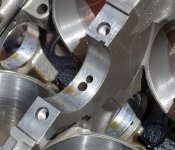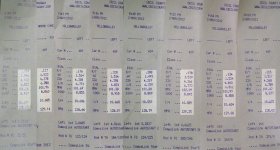If I missed this in another thread please forgive me and remove this thread. I admit i haven't read every post in every thread.
Now being that this is a E-Changer and if your vehicle is a daily driver, is your the E-Charger going to be in continuous use? If so what is the life expectancy of the motors. More so the batteries. So I guess this is where the smart control system comes into play where the system say all boost at higher % of the throttle position or at this rpm range. If no smart system doing a simple WOT switch or the sort.
Ok,
Now when the E-charger is not in use, impeller not spinning how much lose or any lose is happening do to the resistance of the motor not allowing the impeller to turn or turn freely from Air follow coming in on the intake side? Is the E-charger a restrictions at that point? In conventional turbo set the impeller is also in use and in conventional supercharger setups the engine is always driving the supercharger so there is no restrictions or much less restrictions at lower rpm.
If the E-Charger is a restrictions or somewhat of a restrictions, is there enough hp lost to be noticed. Is this something we need to account for in our tune. Now if the motor life expectancy is long from continuous use at low and high rpm use this shouldn't be of much concern.
Now is this the trade off of our E-Charger? Like the conventional units there is tradeoffs, supercharger there is lose do to the engine having to drive another component via the belt system. Turbo using heat exhaust air to make power and lag.
Thoughts please.
Thinking ahead or overthinking it. I was looking at doing an open and close valve when the system is not in use. Basically an open/closed exhaust valve. They comes as large as 3.5", well maybe larger, i just did a search for 3.5" as that is the size of my current intake. Issue would be space to do a such a setup for many.
And honestly I guess it doesn't have to be a valve setup, it could just be a Y-pipe type setup. I wasn't sure how the air from a simple Y-pipe would effect the blower side of the system so the valve system seem like a better solution to the problem (that may not be a problem) than the standard air intake side when the blower is in use. Now like above will this have to be take into consideration in the tune.
Yep maybe i am overthinking this!!
Now being that this is a E-Changer and if your vehicle is a daily driver, is your the E-Charger going to be in continuous use? If so what is the life expectancy of the motors. More so the batteries. So I guess this is where the smart control system comes into play where the system say all boost at higher % of the throttle position or at this rpm range. If no smart system doing a simple WOT switch or the sort.
Ok,
Now when the E-charger is not in use, impeller not spinning how much lose or any lose is happening do to the resistance of the motor not allowing the impeller to turn or turn freely from Air follow coming in on the intake side? Is the E-charger a restrictions at that point? In conventional turbo set the impeller is also in use and in conventional supercharger setups the engine is always driving the supercharger so there is no restrictions or much less restrictions at lower rpm.
If the E-Charger is a restrictions or somewhat of a restrictions, is there enough hp lost to be noticed. Is this something we need to account for in our tune. Now if the motor life expectancy is long from continuous use at low and high rpm use this shouldn't be of much concern.
Now is this the trade off of our E-Charger? Like the conventional units there is tradeoffs, supercharger there is lose do to the engine having to drive another component via the belt system. Turbo using heat exhaust air to make power and lag.
Thoughts please.
Thinking ahead or overthinking it. I was looking at doing an open and close valve when the system is not in use. Basically an open/closed exhaust valve. They comes as large as 3.5", well maybe larger, i just did a search for 3.5" as that is the size of my current intake. Issue would be space to do a such a setup for many.
3.5" Motorized exhaust bypass valve
3.5" Motorized exhaust bypass valve and more!
www.allpurposepipes.com
And honestly I guess it doesn't have to be a valve setup, it could just be a Y-pipe type setup. I wasn't sure how the air from a simple Y-pipe would effect the blower side of the system so the valve system seem like a better solution to the problem (that may not be a problem) than the standard air intake side when the blower is in use. Now like above will this have to be take into consideration in the tune.
Yep maybe i am overthinking this!!


